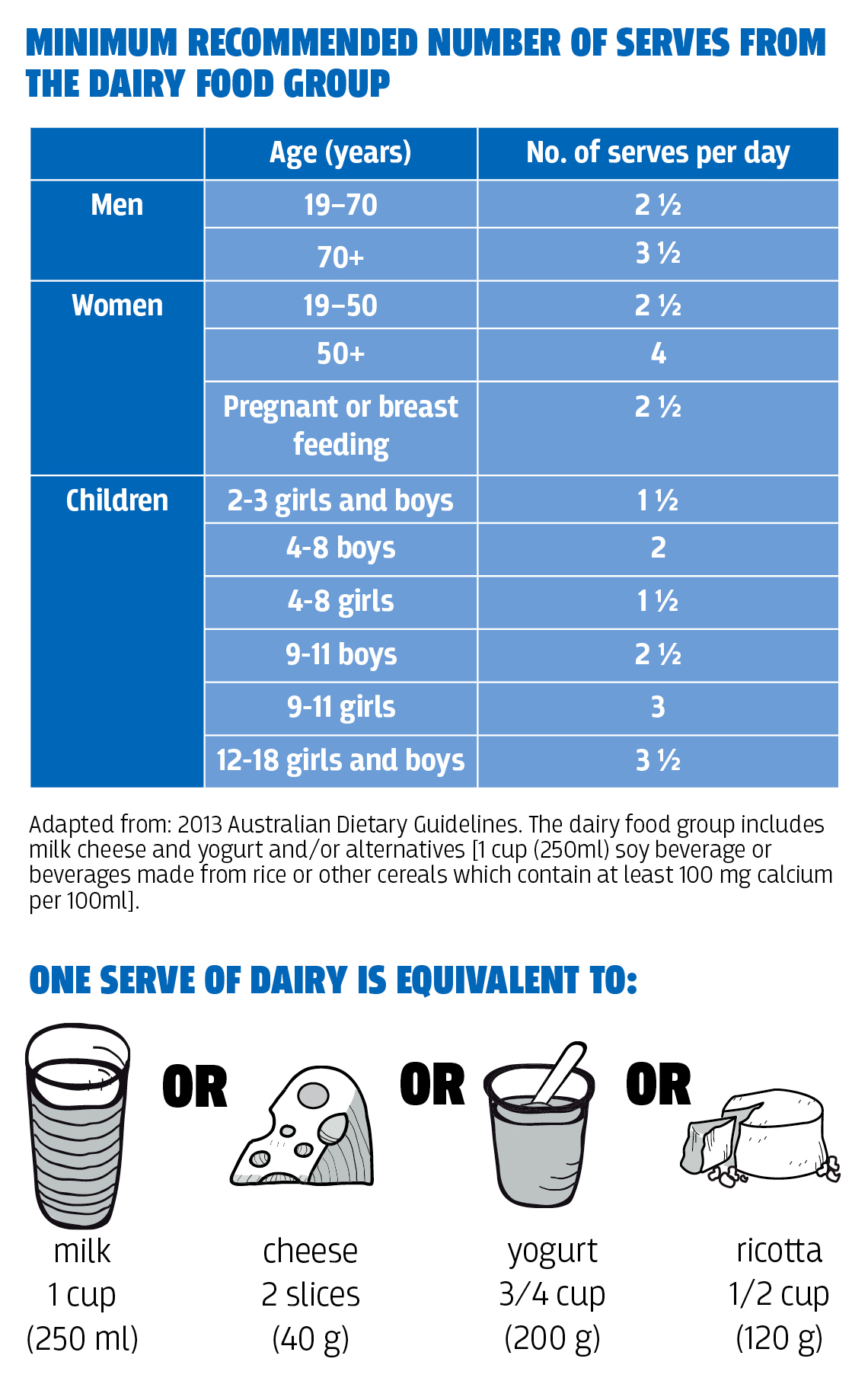
The dairy food group
Milk, cheese and yoghurt form one of the five food groups that make up a balanced diet in the Australian Dietary Guidelines. Dairy foods can play an important role in achieving good nutrition throughout both childhood and adulthood.
Health benefits of dairy foods
There are many established health benefits associated with eating milk, cheese and yoghurt. Alarmingly, 90% of Australian adults are not getting enough dairy in their diets and are missing out on the health benefits.1 Some people avoid dairy in their diet due to the belief that it may be detrimental to heath.
Including milk, cheese and yoghurt as part of a balanced diet is associated with a reduced risk of heart disease, stroke, hypertension, type 2 diabetes, colorectal cancer and the metabolic syndrome.2 The unique package of nutrients and complex physical structure of dairy foods has also been shown to benefit bones, teeth, muscles and weight. 3, 4, 5
The table below lists the essential nutrients found in dairy and their important functions in the body.

How much dairy should people be eating?
Use the table below to see how many serves of dairy foods adults and children need each day.
Learn more about the recommended dairy intake for each of the life stages.
Plant-based 'milk alternatives'
According to the Australian Dietary Guidelines, 'milk alternatives' refer to calcium-enriched legume/bean/cereal milk products such as calcium-enriched soy, rice and oat drinks. To qualify as an alternative, they must contain at least 100mg of added calcium per 100ml.6 These alternative beverages do not contain the same natural package of essential nutrients as cows’ milk and do not have the same proven health benefits. Cows’ milk also contains high-quality protein with all essential amino acids, unlike vegetable protein sources (with the exception of soy). Most plant foods don’t contain much calcium, and those that do often contain other substances that can interfere with your body’s ability to absorb it efficiently.7 For example, to get the same amount of calcium as one serve of dairy, you would need to eat 32 Brussels sprouts or 21 cups of raw chopped spinach or five cups of cooked broccoli or one cup of dry roasted almonds.
Dairy food group resources
Dairy food group position papers
Download the Food matrix white paper
Download the Yoghurt paper
Download the Flavoured milk paper
Download the Cheese paper
Dairy food group fact sheets
Download the How much is enough fact sheet
Dairy food group posters
Download the Dairy food group children poster
Download the Dairy food group adult poster
Dairy food group infographics
Download the Balanced diet infographic
Download the Dairy foods infographic
Expert interview
Accredited Practising Dietitian Glenys Zucco talks about the health benefits of dairy foods and how GPs can help their patients reach their recommended daily serves.
1 Doidge J, Segal L. Most Australians do not meet recommendations for dairy consumption: findings of a new technique to analyse nutrition surveys. Aust N Z J Public Health. 2012;36(3):236-40.
2 National Health and Medical Research Council. Australian Dietary Guidelines, Canberra: Commonwealth of Australia; 2013.
3 Ebeling P, Daly R, Kerr D, Kimlin M. Building bones throughout life: an evidence-informed strategy to prevent osteoporosis in Australia. Med J Aust. 2013;199(7 Supp):S1.
4 Abargouei A, Janghorbani M, Salehi-Marzijarani M, Esmaillzadeh A. Effect of dairy consumption on weight and body composition in adults: a systematic review and meta-analysis of randomized controlled clinical trials. Int J Obes Relat Metab Disord. 2012;36(12):1485-93.
5 Moynihan P, Petersen P. Diet, nutrition and the prevention of dental diseases. Public Health Nutr. 2004;7(1a).
6 National Health and Medical Research Council. Australian Dietary Guidelines, Canberra: Commonwealth of Australia; 2013.
7 Heaney, RP. Bioavailability of the calcium in fortified soy imitation milk, with some observations on method. Am J Clin Nutr 2000;71:1166–9.


